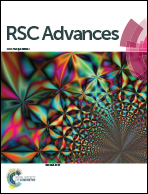Formation of short three dimensional porous assemblies of super hydrophobic acetylene black intertwined by copper oxide nanorods for a robust counter electrode of DSSCs
Abstract
In this study, we synthesized monolithic copper-oxide nanorods (CuO-NRs) and doped into active super hydrophobic acetylene black (AB) nanocrystals via a fast solvation method. The developed short-dimension assemblies are utilized as counter electrode (CE) materials for energy harvesting in dye sensitized solar cells (DSSCs). Cyclic voltammetry and electrochemical impedance spectroscopy analyses reveal that the hybrid (CuO-NRs/AB) CE displays a fast reduction rate of I3− and boosts hole-cascading as compared to those of individual AB CEs, due to the superior catalytic characteristics of CuO-NRs and the good electrical conductivity of AB. The CuO-NRs/AB based DSSCs exhibit an enhanced power conversion efficiency (PCE) of 8.05%, in contrast to AB (6.51%) and pristine Pt (6.96%) CE based DSSCs under the same experimental conditions. The CuO-NRs/AB CE, along with impressive results, has prospective applications in robust DSSCs.


 Please wait while we load your content...
Please wait while we load your content...